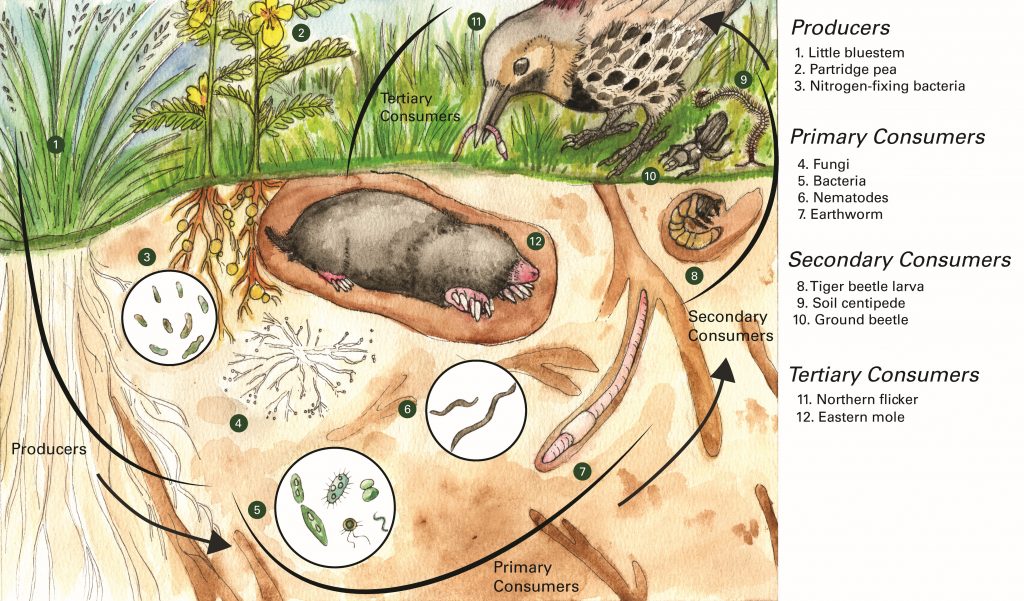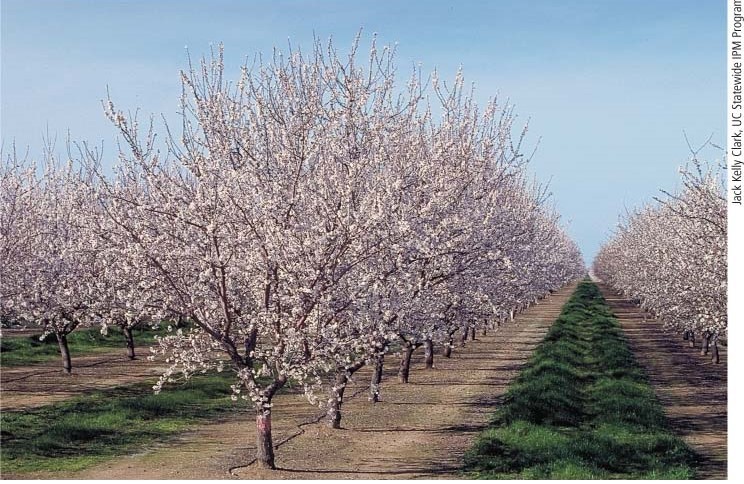Soil life
Cole Dutter
- Explain the importance of soil life
- Compare major classes of organisms found in the soil
- Identify interactions of other soil properties and organisms
- Predict impacts of a management decision on soil organisms
Soil Life is important for the breakdown and stabilization of organic matter, breakdown of toxic compounds, nitrogen fixation and nutrient cycling.

Primary Producers
Primary producers is the term used for organisms that use energy from the sun to create organic molecules (autotrophs). Vascular plants are the most commonly known form of primary producers, however in the soil, other primary producers are mosses, algae, and certain photosynthesizing bacteria. Primary producers hold a central role in soil due to their importance to synthesize and produce new compounds and introduce them to the soil environment. In other words, they are the base of the food web.
Primary Consumers
Primary consumers are organisms that feed off of the primary producers. Some may try to term these organisms herbivores, but that is only a portion of the group considered primary consumers. Herbivores are organisms that eat live plants and contain parasitic nematodes, insect larva, ants, and larger vertebrates. Detritivores are organisms that consume debris from live tissue. Detritivores include larger mesofauna: springtails and mites. A third group is the saprophytic microorganisms. These microorganisms consume dead tissue and include bacteria and fungi. These consumers’ purpose is to break down (decompose) plant and animal tissue and begin to facilitate the cycling of nutrients.
Secondary and Tertiary Consumers
Secondary and tertiary consumers are the predators of the soil, they feed off of other consumers. These consumers include bacteria, fungi, and larger fauna considered carnivores (centipedes, nematodes, snails, etc.). This group can also contain parasites of other animals. This group is titled after the old “food chain” paradigm, thus we distinguish between secondary and tertiary consumers. In the newer paradigm of the “food web” there is less distinction between these two groups. This group helps cycle the nutrients that are stored in the primary consumer group.
Ecosystem Engineers
Ecosystem engineers are larger animals that are capable of altering the physical environment that influence other soil fauna habitat. In the Midwest, these are primarily burrowing animals such as ants, worms, or gophers. These animals affect air and water movement through the soil, as well as create channels for plant roots.
Not all earthworms help the soil: Check out this study!
Producer Consumer Symbiosis
Symbiotic relationships occur between the plants and microbes because they are both benefiting from each other. The plant is able to provide a food source and home for the microbes and, in exchange, the microbes provide the plant with nutrients it requires.
Soil fungi that have formed symbiotic relationships with plants is one of the most economically important groups of soil organisms. Mycorrhizae have been studied for benefits such as increased drought tolerance and increased phosphorus uptake in crops. Mycorrhizal fungi also help soil structure by contributing to aggregation through the production of glomalin.
Rhizobium or Bradyrhizobium bacteria species are best known for their relationships with legumes. These species are not generalists but are either host specific or have a range of hosts, however they do not inoculate all legume species. These species are responsible for the root nodules on legumes that fix nitrogen. Fixing nitrogen is a critical function because it takes nitrogen from the air and makes it available for the plants to use.
Rhizobacteria is a term for the bacteria that have adapted to living along the root surface. These species are the most common symbiosis, yet are seldom studied. The root surface becomes so encrusted with bacteria that little soil actually interacts with the root without some intervening microbial influence. These species assist in cycling nutrients near the root, including nitrogen. Rhizobium are the face of nitrogen fixation yet Rhizobacteria also help supply nitrogen to the plant as well.
There are also pathogenic species as well! Sudden Oak Death is a Phytophthora species that kills trees. Named for the fact that early victims of this disease were oaks, this species can also prey on agriculturally important species such as Almonds. Sudden Death Syndrome is caused by a Fusarium species and is common in soybeans. Phytophthora and Fusarium are two genera that contain many diseases that attack economically important plants. Examples include: damping off disease, root and stem rot, crown rot, fusarium wilt, and fruit rot. These diseases are commonly controlled through crop rotation and planting resistant varieties.
Management and Soil Life
Soil life, in general, needs two things to thrive: minimized disturbances and an adequate food source. In terms of management this means that practices that increase soil organic matter, decrease erosion, and increase soil structure are the key to increasing microbial communities and thus nutrient cycling. This can take many forms but there are two easy management practices that fulfill this: no-till and cover crops. Generally speaking, it can be said that “life creates life.” One interpretation of this is that the more plants there are on the ground, the more microbial activity there is in the ground. In California, farmers are often concerned with weeds competing for water with the crop. Which leads to the implementation of strip spraying (pictured below).

Removing the plants around the trees may reduce the amount water used, but it also reduces the amount of nutrients cycled near the tree in the early years of the orchard. As a consequence of this, many nutrients need to be applied either by pelletized fertilizer or foliar application. Similarly cover crops may cost the farmer a little more, but the plants contributions to microbial food sources or food complexity is important for a sustained robust microbial community.
Soil aggregation, facilitated by no-till agriculture, is not simply for better drainage and less erosion. Soil aggregation is important for niche complexity within the soil environment. Niche complexity allows for community complexity. Soil life, much like all forms of life, is not homogenous. Certain microbes may do well in saturated soils, others like drier spaces. A stable aggregate allows for the microbes to find their niche, the moisture desiring microbe will colonize the outside of the aggregate while the other will colonize the interior of the aggregate.
Disease pressure in the soil can be tricky to manage, however, one of the best methods to simply manage it is to rotate crops or plant resistant varieties. Soil fumigants can be used but commonly are expensive and difficult to employ. In California, the threat of nematodes have caused farmers to fumigate their fields with methyl bromide. This procedure was effective for two reasons, the farmers deep rip the field to open up the soil and the soil texture is sand to sandy loam. This allowed for effective use of the fumigants. Methyl bromide has now been phased out and farmers are struggling to find effective fumigants for the soil borne diseases. The new fumigants are targeted towards specific pests within the soil and are not generalists. While farmers complain about the ineffectiveness of the new fumigants, the overall effect will be for a healthier soil.
- Soil Life is important for a variety of reasons:
- Breakdown and stabilization of organic matter
- Breakdown of toxic compounds
- Nitrogen fixation
- Nutrient uptake and cycling
- Mycorrhizal associations with plants influence:
- Drought tolerance
- Nutrient uptake
- Soil Structure
- Management effects soil life in three ways:
- Food sources
- Disturbances
- Disease cycles

